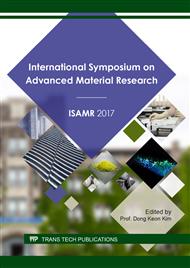[1]
A. Fujishima, K. Honda, Electrochemical photolysis of water at a semiconductor electrode, Nature, 238 (1972) 37-38.
DOI: 10.1038/238037a0
Google Scholar
[2]
A. Fujishima, X. Zhang, D. A. Tryk, TiO2 photocatalysis and related surface phenomena, Surf. Sci. Rep. 63 (2008) 515.
DOI: 10.1016/j.surfrep.2008.10.001
Google Scholar
[3]
M. R. Hoffmann, S. T. Martin, W. Y. Choi, D. W. Bahnemann, Environmental Applications of Semiconductor Photocatalysis, Chem. Rev. 95 (1995) 69.
DOI: 10.1021/cr00033a004
Google Scholar
[4]
K. Rajeshwar, Materials aspects of photoelectrochemical energy conversion, J. Appl. Electrochem. 15 (1985) 1.
Google Scholar
[5]
K. Rajeshwar, Hydrogen generation at irradiated oxide semiconductor-solution interfaces, J. Appl. Electrochem. 37(7) (2007) 765–787.
DOI: 10.1007/s10800-007-9333-1
Google Scholar
[6]
A. M. Handerson, A surface science perspective on TiO2 photocatalysis, Surf. Sci. Rep. 66 (2011) 185.
Google Scholar
[7]
T. Kasuga, M. Hiramatsu, A. Hoson, T. Sekino, K. Niihara, Formation of titanium oxide nanotube, Langmuir, 14 (1998) 3160-3163.
DOI: 10.1021/la9713816
Google Scholar
[8]
T. Kasuga, M. Hiramatsu, A. Hoson, T. Sekino, K. Niihara, Titania nanotubes prepared by chemical processing, Adv. Mater. 11 (1999) 1307-1311.
DOI: 10.1002/(sici)1521-4095(199910)11:15<1307::aid-adma1307>3.0.co;2-h
Google Scholar
[9]
Q. Chen, W. Zhou, G. H. Du, L. M. Peng, Trititanate nanotubes made via a single alkali treatment, Adv. Mater. 14 (2002).
DOI: 10.1002/1521-4095(20020903)14:17<1208::aid-adma1208>3.0.co;2-0
Google Scholar
[10]
K. Kiatkittipong, J. Scott, R. Amal, Hydrothermally synthesized titanate nanostructures: Impact of heat treatment on particle characteristics and photocatalytic properties, ACS Appl. Mater. Interf. 3 (2011) 3988-3996.
DOI: 10.1021/am2008568
Google Scholar
[11]
Z. Y. Yuan, J. F. Colomer, B. L. Su, Titanium oxide nanoribbons, Chem. Phys. Lett. 363 (2002) 362-366.
Google Scholar
[12]
K. Kiatkittipong, C. Ye, J. Scott, R. Amal, Understanding Hydrothermal Titanate Nanoribbon Formation, Cryst. Growth & Des. 10 (2010) 3618-3625.
DOI: 10.1021/cg1004984
Google Scholar
[13]
Y. X. Zhang, G. H. Li, Y. X. Jin, Y. Zhang, J. Zhang, L. D. Zhang, Hydrothermal synthesis and photoluminescence of TiO2 nanowires, Chem. Phys. Lett. 365 (2002) 300-304.
DOI: 10.1016/s0009-2614(02)01499-9
Google Scholar
[14]
R. Yoshida, Y. Suzuki, S. Yoshikawa, Syntheses of TiO2 (B) nanowires and TiO2 anatase nanowires by hydrothermal and post-heat treatments, J. Solid State Chem. 178 (2005) 2179-2185.
DOI: 10.1016/j.jssc.2005.04.025
Google Scholar
[15]
A. R. Armstrong, G. Armstrong, J. Canales, P. G. Bruce, TiO2 -B nanowires, Angew. Chem. Int. Ed. 43 (2004) 2286-2288.
DOI: 10.1002/anie.200353571
Google Scholar
[16]
K. Byrappa, M. Yoshimura, Handbook of Hydrothermal Technology - A Technology for Crystal Growth and Materials Processing. William Andrew Publishing/Noyes, (2001).
Google Scholar
[17]
R. Ma, Y. Bando, T. Sasaki, Nanotubes of lepidocrocite titanates, Chem. Phys. Lett. 380 (2003) 577-582.
DOI: 10.1016/j.cplett.2003.09.069
Google Scholar
[18]
G. Centi, S. Perathoner, Catalysis by layered materials: A review, Microp. Mesop. Mater. 107 (2008) 3-15.
Google Scholar
[19]
K. I. Shimizu, Y. Tsuji, T. Hatamachi, K. Toda, T. Kodama, M. Sato, et al., Photocatalytic water splitting on hydrated layered perovskite tantalate A2 SrTa2O7 nH2O (A = H, K, and Rb), Phys. Chem. Chem. Phys. 6 (2004) 1064-1069.
DOI: 10.1002/chin.200422022
Google Scholar
[20]
A. Kudo, Y. Miseki, Heterogeneous photocatalyst materials for water splitting, Chem. Soc. Rev. 38 (2009) 253-278.
DOI: 10.1039/b800489g
Google Scholar
[21]
M. Kitano, M. Hara, Heterogeneous photocatalytic cleavage of water, J. Mater. Chem. 20 (2010) 627-641.
DOI: 10.1039/b910180b
Google Scholar
[22]
A. Kudo, Photocatalyst materials for water splitting, Catal. Surv. Asia, 7 (2003) 31-38.
Google Scholar
[23]
V. Vamathevan, R. Amal, D. Beydoun, G. Low, S. McEvoy, Silver metallisation of titania particles: Effects on photoactivity for the oxidation of organics, Chem. Eng. J. 98 (2004) 127-139.
DOI: 10.1016/j.cej.2003.05.004
Google Scholar
[24]
A. Mirigul, Y. Huseyin, Mechanical and Antibacterial Properties of Injection Molded Polypropylene/TiO2 Nano-Composites: Effects of Surface Modification, J. Mater. Sci. Technol. 28(8) (2012) 686–692.
DOI: 10.1016/s1005-0302(12)60116-9
Google Scholar


